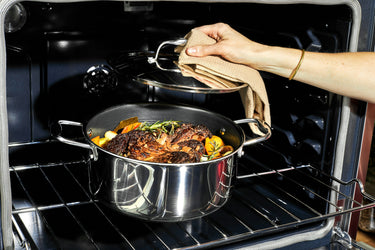The 4 Dishes You Should Make In A Dutch Oven

Spend enough time around dedicated cooks, and you’re likely to hear at least one wax poetic about their favorite kitchen items. On the short list for most? Their Dutch oven. It’s no wonder since this heavy-duty, lidded pot turns out everything from fall-off-the-bone tender roasts to crackly crusted sourdough to perfectly fried chicken.
A Dutch oven has a thick, heavy bottom with deep sides, ideal for trapping and distributing heat. Despite its name, the Dutch oven doesn’t hail from the Netherlands. It was an Englishman named Abraham Darby who studied the method of making molded cast iron in Holland in the early 18th century before bringing the trade to his homeland. The name for this “Dutch method” stuck to lidded cast iron pots. Used since Colonial times in America, the Dutch oven’s versatility even made it a companion of early explorers across North America, including John Colter, who broke off from Lewis and Clark’s expedition to roam the area now known as Yellowstone National Park.
Though historically made with cast iron, now Dutch ovens can be found in stainless steel and nonstick varieties (like HexClad’s own Dutch Oven), which makes them much lighter to handle and easier to clean. Not to mention, you’re much less likely to lose precious bits of chicken skin to an underheated surface.
Though the Dutch oven is known as the go-to pot for low-and-slow cooking (think: pot roast, Hungarian goulash, and coq au vin), a Dutch oven is suited for more than just braises. Use it for perfect egg poaching, chili, pasta sauces, peach cobbler, and more. It’s worth breaking out beyond the tried-and-true classics that Dutch ovens are known for. Here are our 4 favorite dishes to make in a Dutch oven:
Roast Chicken, aka Chicken en Cocotte
There are few universal truths, but one of them is surely that juicy chicken is better than dry. The foolproof way to get there? Roasting inside a covered dish. This method, known as “en cocotte” in French, requires no liquid. Instead, you’ll roast the chicken inside a dry Dutch oven in a low-temperature oven (around 1½ hours at 250ºF). This causes the chicken to release any liquid into the pot, which creates a moist-heat environment that essentially braises the chicken in its own juices. The resulting meat is tender and extra flavorful, rather than being diluted by other liquid or dried out when roasted on a pan. Bonus: the pan juices make for an exceptional sauce. Just A Pinch has a great rendition of chicken en cocotte.
Bakery-Worthy Bread
Commercial bakeries have supercharged ovens that can maintain a very high temperature and can insert steam at crucial points during baking. Home ovens aren’t as stable, nor do they have the fancy steam options. Enter the Dutch oven, which distributes the heat evenly and creates a more intense heat environment for the dough. A Dutch oven also traps the humidity released by the dough during baking, which turns into steam. The steam keeps the exterior of the dough soft enough to expand and contributes to the final bread’s shiny crust. Get started with this recipe from Taste of Home.
Boeuf Bourguignon
Channel your inner Julia Child with this classic French dish. Boeuf Bourguignon is a beef stew that calls for browning chunks meat in oil. This can be a finicky step in a cast iron Dutch oven if the heat level isn’t right, but in a nonstick Dutch oven, there’s no fear of the pieces sticking. Simmered with carrots, onions, mushrooms, and wine, the result is a warming dish perfect for winter nights and laid back dinner parties. Don’t skimp on the red wine, and serve with a loaf of your Dutch oven bread. We like Serious Eats’ classic version of Boeuf Bourguignon.
Perfect Pork Cutlets
Sure, you can fry up breaded pork cutlets in a straight-sided skillet or another pot, but the Dutch oven’s deep sides and superior ability to maintain consistent temperature make this the perfect pot for cooking schnitzel worthy of a Viennese restaurant. (Your Dutch oven is ideal for all things fried since it keeps the temperature more consistent than other pots. Choose it for fried chicken, French fries, donuts, and tempura.) Here’s a great recipe to start with, from the New York Times.
Once you’re done cooking, let the pot cool completely, then either wash it by hand with a gentle soap and a non-abrasive sponge, or, if it’s a HexClad Dutch oven, it’s dishwasher-friendly. For a cast-iron Dutch oven, you’ll want to follow best practices for cast-iron, which means no abrasive sponges or cleaners. Wipe any residue and bits of food off the surface, then gently clean with a soft sponge and a few drops of dish soap. Dry immediately.





